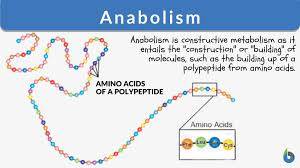CATABOLISM
Catabolism is the part of the metabolism that breaks down complex molecules into smaller units that release energy. Catabolism is also known as the destructive or degradative phase of metabolism, as it involves breaking down the bonds of large molecules, such as carbohydrates, lipids, proteins, and nucleic acids. Catabolism provides the chemical energy that is needed for the maintenance and growth of cells, as well as for other metabolic processes. Some examples of catabolic reactions are glycolysis, the citric acid cycle, and oxidative phosphorylation.
Catabolism is regulated by various hormones and molecules that control the rate and extent of the breakdown of molecules. Some of the hormones that are associated with catabolism are cortisol, glucagon, adrenaline, and cytokines. These hormones stimulate the release of glucose and fatty acids from the storage tissues, such as the liver, muscles, and adipose tissue, and increase their availability for energy production. Catabolism is also influenced by the molecules involved in metabolism itself, such as ATP, NADH, and acetyl-CoA. These molecules act as feedback signals that indicate the energy status of the cell and modulate the activity of enzymes involved in catabolic pathways.
Catabolism is essential for life, as it provides the energy and building blocks for various biological functions. However, excessive or unbalanced catabolism can have negative effects on health and well-being. For example, prolonged stress or starvation can lead to increased catabolism of muscle protein, resulting in muscle wasting and weakness. Catabolism can also produce harmful by-products, such as reactive oxygen species (ROS), ammonia, and urea, that need to be eliminated or detoxified by the body.
ANABOLISM
Anabolism is the part of the metabolism that builds larger and more complex molecules from smaller and simpler ones. It is also known as biosynthesis. Anabolism requires energy, which is usually provided by the breakdown of other molecules in catabolism. Anabolism is involved in various processes in living cells, such as protein synthesis, DNA synthesis, and growth of bones and muscles.
Some Examples of Anabolic Hormones are
- Insulin – It promotes absorption of glucose
- Anabolic steroids – It helps in stimulating muscle growth
- Anaerobic exercise – It helps in building muscle mass
Stages of Anabolism
There are three stages in anabolism. They are
- Production of precursors such as monosaccharides, nucleotides, amino acids, and isoprenoids.
- Activation of the above-mentioned precursors into reactive forms with the help of energy from ATP.
- Assemble the precursors to form complex molecules such as polysaccharides, nucleic acids, proteins, and lipids.
Energy Sources for Anabolic Processes
Various species depend on various sources of energy. A few have been discussed below:
- Autotrophs – Formation of complex organic molecules such as proteins and polysaccharide in plant cells from simple molecules like water and carbon dioxide with the help of sunlight as an energy source.
- Heterotrophs – They require complex substances such as amino acids and monosaccharides to produce these complex molecules.
- Photoheterotrophs and photoautotrophs – They obtain energy from light
- Chemoheterotrophs and chemoautotrophs get energy from inorganic oxidation reactions.
Anabolism Functions
The nutrients from food are broken down into small blocks in the catabolic pathway. Macromolecules are formed when small molecules are combined. During the anabolic pathway, energy is utilized to generate large molecules by forming chemical bonds between the smaller molecules. These macromolecules are further used to build new cells or structure the cells. Anabolism is essential for maintenance, growth, and development of a cell.
HOW DOES ANABOLISM RELATE TO CATABOLISM?
Anabolism and catabolism are two types of metabolic processes that are related to each other. Anabolism is the process of building complex molecules from simpler ones, while catabolism is the process of breaking down large molecules into smaller ones. Both processes involve chemical reactions that occur in the cells of living organisms. Anabolism and catabolism are interdependent and complementary, as they work together to maintain the balance and function of the metabolism.
One way that anabolism and catabolism are related is that they share a common source of energy: adenosine triphosphate (ATP). ATP is a molecule that stores and transfers energy in the cells. Catabolic reactions release energy by breaking down molecules, such as carbohydrates, lipids, proteins, and nucleic acids. Some of this energy is used to synthesize ATP from adenosine diphosphate (ADP) and inorganic phosphate (Pi). Anabolic reactions use energy by building up molecules, such as amino acids, nucleotides, fatty acids, and sugars. Some of this energy is obtained from ATP by hydrolyzing it into ADP and Pi. Thus, ATP acts as a link between catabolism and anabolism, as it is both produced and consumed by these processes.
Another way that anabolism and catabolism are related is that they regulate each other through feedback mechanisms. Feedback mechanisms are systems that monitor and adjust the activity of metabolic pathways according to the needs and conditions of the cell. For example, when the cell has enough glucose, it can inhibit the catabolic pathway of glycolysis, which breaks down glucose into pyruvate. This can prevent the wasteful use of glucose and save it for later use. Conversely, when the cell needs more glucose, it can activate the anabolic pathway of gluconeogenesis, which synthesizes glucose from noncarbohydrate sources. This can increase the availability of glucose for energy production or storage.
In summary, anabolism and catabolism are related metabolic processes that involve the transformation of molecules in the cells. They share a common source of energy (ATP) and regulate each other through feedback mechanisms. They work together to maintain the balance and function of the metabolism.
I hope you found this answer informative and useful. Thank you for using Bing chat mode. blush


